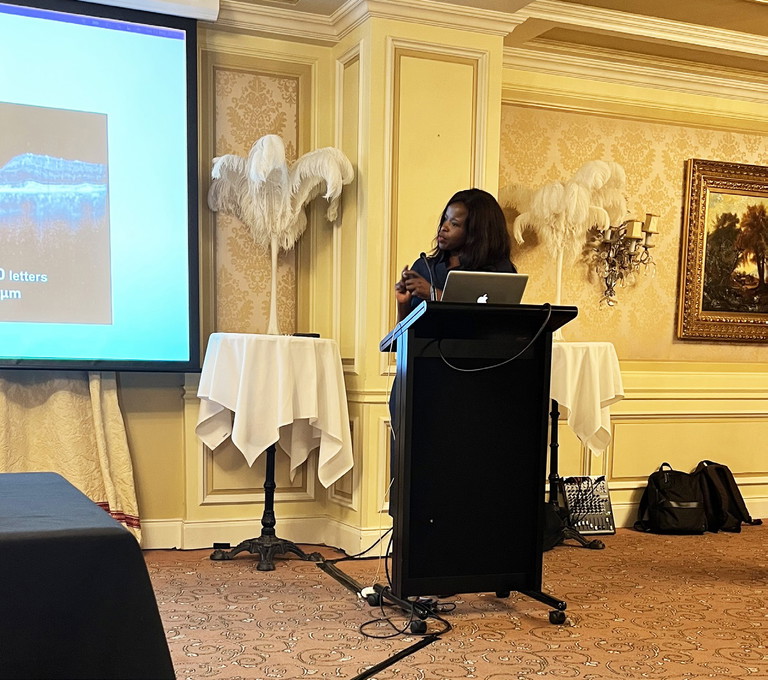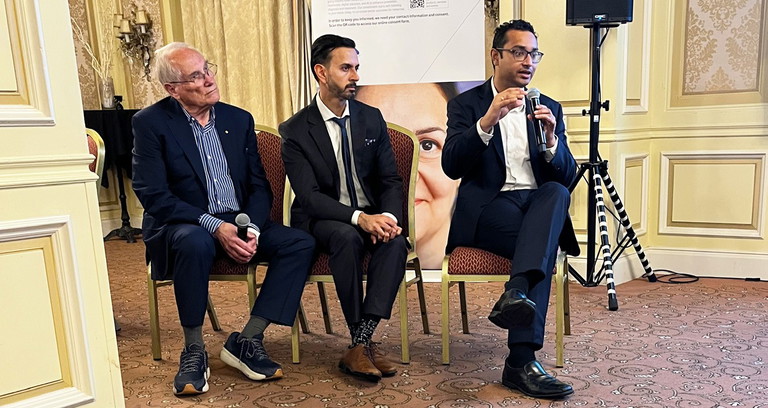mievent

Dr Christiana Dinah
Vabysmo Revolutionising nAMD Treatment in the UK
The availability of Vabysmo (faricimab) is making a significant dent on the enormous backlog of patients in the United Kingdom awaiting anti-VEGF treatment for neovascular age related macular degeneration (nAMD).
Dr Christiana Dinah, a consultant ophthalmologist and Director of Research and Development at London North West Healthcare National Health Service (NHS) Trust, was recently in Australia and New Zealand meeting with local ophthalmologists to share experiences treating nAMD patients. I was fortunate to chat with her ahead of a formal dinner.
WRITER Melanie Kell
In Sydney, Dr Dinah joined Associate Professor Hemal Mehta (the evening’s Chair), Professor Paul Mitchell AO, and Dr Gaurav Bhardwaj at an educational dinner event hosted by Roche.
CHALLENGE OF A UK BACKLOG
Setting the scene for eye health in England, Dr Dinah told the audience that nAMD remains the highest cause of sight loss in the country, with over 70,000 new cases diagnosed annually. And with almost all ophthalmology provided by the public health system, she said that since the introduction of antiVEGF treatments, the NHS has come under enormous pressure to expand its services.
“The expansion in our services and the demand, as we have an ageing population, is difficult to quantify,” Dr Dinah explained. She presented data showing one of the largest NHS Trusts in England delivering approximately 25,000 nAMD injections annually, with thousands more for diabetic macular oedema (DMO) and retinal vein occlusion (RVO).
This is against a background of one of the lowest numbers of ophthalmologists per capita in all of Europe. To manage this increasing burden, the NHS has implemented several strategies, including rapid access clinics with a two-week pathway from optometrist referral to first injection, an expanded workforce with over 70% of injections delivered by nurses and allied health professionals under ophthalmology supervision, and development of diagnostic hubs outside hospital settings.
Despite these innovations, NHS ophthalmology remains under immense pressure. “In the NHS, we have increasing demand, exacerbated by the backlog that developed during the COVID pandemic. Ophthalmology is now the busiest outpatient specialty in the UK,” Dr Dinah noted.
UNIQUE MICROCOSM OF BRENT
Dr Dinah consults at the Central Middlesex Hospital in Brent, one of London’s most ethnically diverse boroughs with over 150 languages spoken. The area has one of the UK’s highest prevalence rates of diabetes, and many patients have commitments abroad, making regular injection appointments challenging.
By January 2022, post-COVID, her service was receiving four new nAMD referrals weekly, conducting 800–1,000 diabetic eye screening referrals annually, and performing approximately 6,000 injections yearly. This included regular Saturday clinics to address the backlog, with 25% of patients requiring four to five-weekly injections.
A 12-month audit of 135 eyes with wet AMD treated at Dr Dinah’s clinic since the release of Vabysmo showed remarkable improvements in treatment intervals and outcomes:
• Mean treatment intervals increased to 10.2 weeks for treatment-naïve patients and 8.8 weeks for treatment-resistant patients,
• 47% of treatment-naïve patients were extended to 12 weeks or longer between injections,
• Only 2% required high-frequency (fourweekly) injections, and
• 75% of eyes achieved absence of intraretinal and subretinal fluid within two injections.
On a national scale, she said Vabysmo’s extended durability has significant implications for capacity and patient care. Referencing realworld data from the UK FARWIDE studies that demonstrate reduction in injection numbers after the loading phase supporting her own real-world evidence, she remarked that “Almost 80% of eyes in year one and in year two achieve Q12 or longer durability in the pivotal trials”.
The dual mechanism appears to provide faster disease control, with post-hoc analysis from the LUCERNE and TENAYA trials showing 75% of Vabysmo-treated eyes achieving absence of fluid within two injections, compared to three injections with aflibercept, she said.
With patients in Brent now requiring treatment less often, ophthalmologists and their teams need only work one Saturday a month to manage patient care.
THE SCIENCE OF DUAL INHIBITION
Dr Dinah believes that Vabysmo’s dual action is making the difference. The first dual-inhibition therapy in the retina space, it facilitates bi-specificity, with one arm inhibiting vascular leakage and neovascularisation by blocking VEGF-A. The other blocks angiopoietin-2(Ang2).
This dual action addresses multiple disease pathways. “Elevated Ang2 leads to vascular instability. Ang2 and VEGF-Aare elevated in DMO and nAMD, so biologically it’s plausible that if you inhibit these two cytokines, you’ll influence fibrosis, inflammation, vascular leakage, and neovascularisation, resulting in improved vascular stability.”
Dr Bhardwaj, who practises across Westmead, Liverpool, and the Sydney Children’s Network, also spoke about Vabysmo’s dual mechanism – describing it as a therapy that potentially offers improved efficacy and duration over traditional anti-VEGF agents.
With traditional anti-VEGF he said, “we’ve always thought that we’re simply just temporarily drying up the retinal fluid, but the disease continues to progress... Perhaps we’ll see an increased amount of true regression of these lesions with a combination of blockade of angiopoietin-2along with VEGF-A.”
TRUCKEE DATA
Drawing from the ongoing TRUCKEE realworld study1 conducted across 14 United States sites, Dr Bhardwaj reported significant anatomical improvements in patients switching to Vabysmo. The unpublished 2.5-year data included nearly 3,600 eyes with almost 18,000 Vabysmo injections.
“Patients are able to have fewer treatments and the retinas are drier, and perhaps that might contribute towards maintenance of the vision long term,” he noted.
For switch patients previously on aflibercept, treatment intervals increased by nearly three weeks after nine Vabysmo injections, representing “a fairly meaningful change in the treatment interval of these patients”.
He reported that the safety profile remained reassuring across the large cohort, with intraocular inflammation rates of just 0.11% and endophthalmitis at 0.02%.
Having painstakingly collated and analysed his own clinic data, Dr Bhardwaj presented on 62 eyes across the three private practices he consults from. His treatment-naïve patients improved from 6/22 to 6/18 vision on average, with 21 of 22 patients dry at final follow-up. Among switch patients, 82% achieved dry status with an average four-week extension in treatment intervals.
“I’ve certainly found a good safety profile. I haven’t had any patients with serious adverse events related to Vabysmo, which gives me a lot of security and peace of mind,” Dr Bhardwaj concluded.
He noted that while vision benefits were more pronounced in treatment-naïve patients, switch patients primarily benefited from increased durability and treatment extension.
MIRRORED OUTCOMES
Prof Mitchell shared extensive real-world data on Vabysmo treatment outcomes from his Western Sydney clinic. Since the introduction of Vabysmo in 2023, the clinic has administered over 10,374 vials of this therapy, primarily to treatmentnaïve patients. The clinic, serving a diverse population with high diabetes rates, manages approximately 1,000 AMD and 1,200 DMO patients annually, with around 500 new cases presenting each year.
Prof Mitchell said his outcomes are comparable or superior to pivotal trials for both DMO and nAMD, and also mirror those reported by Dr Dinah.
For DMO, data from 181 eyes of 177 treatment-naïve patients showed promising results. “After four loading doses and some extension, we’ve got 6.6 [letter gain] and CST (central subfield thickness) was reduced by about 108 microns,” he observed.
This cohort had a mean follow-up of 34 weeks with average treatment extension to 11 weeks after loading doses. Importantly, 50% of eyes extended treatment intervals beyond 12 weeks.
For nAMD, the clinic evaluated 121 eyes from 111 treatment-naïve patients. The mean vision gain was higher than in pivotal trials, with patients achieving almost a nine letter gain after loading doses compared to 6.2 in the TENAYA and LUCERNE trials,2 “likely reflecting worse baseline vision in the real-world cohort”.
Similar to DMO patients, the nAMD group achieved an average treatment extension to 11 weeks after loading doses, with 59% of eyes extended to 12 weeks or more, Prof Mitchell said.
Like Dr Dinah, Dr Bhardwaj, and Assoc Prof Mehta, Prof Mitchell reported very few complications with Vabysmo. Dr Dinah reported that the therapy’s ability to rapidly dry sub-RPE fluid could potentially lead to an RPE tear in patients with large pigment epithelial detachments (PEDs). For this reason, Dr Dinah treats these patients with caution, counselling them on the risks of treatment and using alternative agents to slowly dry fluid until the PED is stabilised, at which point she switches them to Vabysmo.
VABSYMO PBS LISTED FOR RETINAL VEIN OCCLUSION
Vabysmo was PBS listed for the management of macular oedema secondary to RVO on 1 March 2025. Assoc Prof Mehta shared a case of a patient with a branch retinal vein occlusion with associated cystoid macular oedema who was enrolled in the BALATON clinical trial at Strathfield Retina Clinic. He subsequently had ongoing access to Vabsymo after the trial ended as part of a special access scheme. The patient now had four years of follow-up with an excellent visual outcome. Assoc Prof Mehta commented “it is great to see a medication I first used in a clinical trial setting now available to over 20,000 Australians affected by RVO”.
A GLOBAL LEARNING OPPORTUNITY
Having travelled Australia and New Zealand to meet and speak with ophthalmologists, and to visit both public and private ophthalmology settings, Dr Dinah told me the “immersive” experience had been filled with opportunities to learn and compare two very different approaches to treating the ever-growing population of patients with macular disease.
When I asked which she preferred, she acknowledged that both approaches had their advantages however in the UK, the ability to scale resources by training optometrists and nurses to work alongside the limited supply of ophthalmology consultants had the greatest promise for managing an increasing need.
“We have trained and used nurses and optometrists for examining and injecting nAMD patients in the UK since 2011. We now have national protocols that ensure standardised training, which ensures consistency of care, and ophthalmologists are always on hand to provide oversight.” However, she conceded more remains to be done to improve the UK model and overcome the national backlog of patients – saying it primarily comes down to funding the training, retention, and renumeration of a larger pool of ophthalmologists. Dr Dinah said, “The UK has an extremely low number of ophthalmologists per capita, second only to Macedonia in Europe. Therefore, longer acting drugs that help support additional capacity are very welcome.”

Professor Paul Mitchell, Dr Gaurav Bhardwaj, and Associate Professor Hemal Mehta.